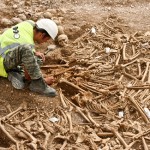 It’s not yet confirmed that they were Viking raiders, but evidence suggests that the 51 skeletons unearthed near Weymouth, on the southern coast of England, were a raiding party who encountered unexpectedly effective Saxon opposition and paid for it with their heads.
It’s not yet confirmed that they were Viking raiders, but evidence suggests that the 51 skeletons unearthed near Weymouth, on the southern coast of England, were a raiding party who encountered unexpectedly effective Saxon opposition and paid for it with their heads.
(And their clothes. They were found nekkid.)
Many of the skeletons have deep cut marks to the skull and jaw as well as the neck. “The majority seem to have taken multiple blows,” Score said.
The bodies show few signs of other trauma, suggesting the men were alive when beheaded.
One victim appears to have raised an arm in self-defense: “The hand appears to have had its fingers sliced through,” Score noted.
The heads were neatly piled to one side of the pit, perhaps as a victory display, the team suggests.
The burial dates to sometime between 890 and 1034 AD, which was peak Viking longship era.
The method of burial suggests that the locals did the killing, because Viking raiders didn’t drop the raiding to carefully stack heads and bury the enemy dead. They killed and kept on raiding, leaving bodies in their wake.
The location of the burial — atop a hill by the main road to Weymouth — also supports the theory that the deceased were killed by the people who lived there.
A chemical analysis of the dead guys’ teeth should confirm whether they were grew up in Scandinavia or England, and a closer analysis of the bones will reveal what kind of muscle development the strapping youths had.
If, for instance, their bones show evidence of overdeveloped arms and shoulders, that would suggest they were oarsmen.